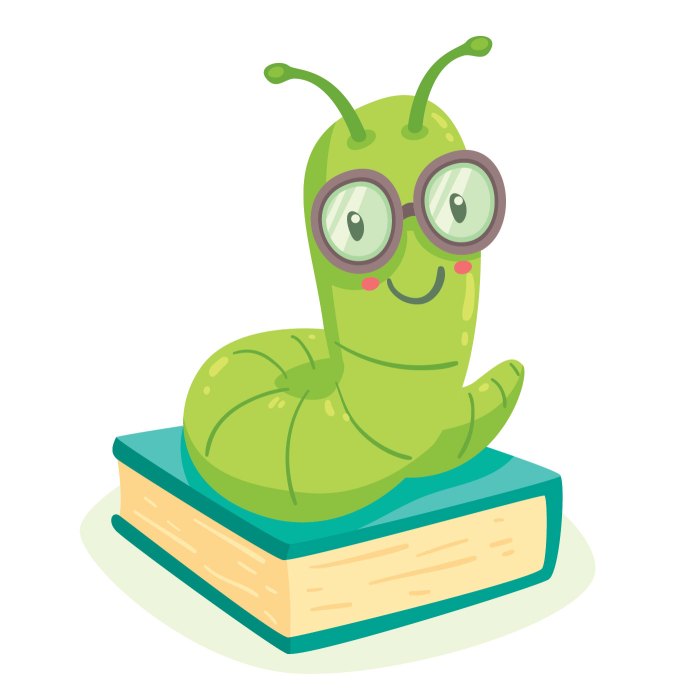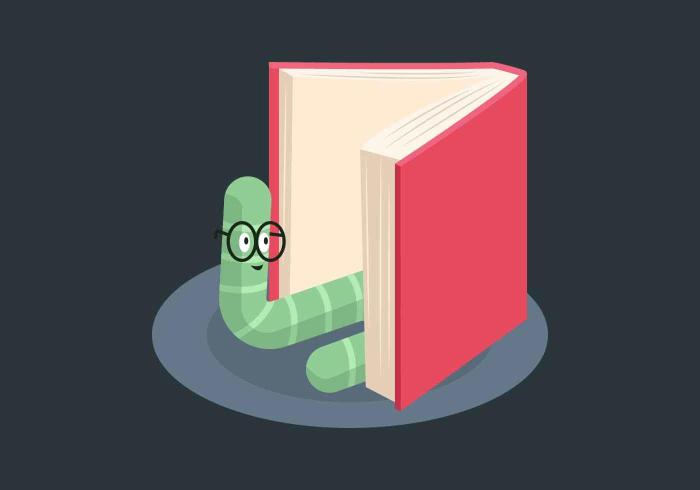Simple Bookworm Drawing Techniques

Book worm easy drawing – Drawing a bookworm is a fun and easy activity, perfect for beginners. This guide provides step-by-step instructions using only basic shapes and simple details, making it accessible to everyone. We’ll cover creating the basic body shape, adding features, and applying different patterns.
Creating the Basic Bookworm Shape, Book worm easy drawing
Start by drawing a long, slightly curved oval. This will form the bookworm’s body. Imagine a slightly squashed circle stretched out horizontally. Then, add two smaller, slightly overlapping circles at one end of the oval. These will be the bookworm’s head.
The circles should be positioned so they create a rounded head shape. Finally, connect the head circles smoothly to the main body oval, ensuring a natural flow. The result is a simple, elongated shape resembling a worm.
Adding Details: Eyes, Antennae, and Legs
To add eyes, draw two tiny black circles inside the smaller head circles. For antennae, draw two short, slightly curved lines extending from the top of the head. These lines should be thin and delicate. For legs, draw small, short lines extending from the bottom of the bookworm’s body along its length. These lines should be evenly spaced and slightly curved downwards, giving the impression of tiny legs gripping the page.
Keep these details small and simple to maintain the overall easy-to-draw nature of the bookworm.
Bookworm Pattern Methods
Several methods can add visual interest to your bookworm drawing. These methods are easy to apply and enhance the bookworm’s appearance.
Method 1: Stripes Draw parallel lines of equal width along the length of the bookworm’s body. You can vary the colors to create a more dynamic striped pattern. For example, alternate between red and yellow stripes for a vibrant look. Imagine a zebra’s stripes but scaled down to fit the bookworm’s body.
Method 2: Spots Draw several small circles of varying sizes randomly across the bookworm’s body. These spots can be the same color or various colors for a more playful appearance. Imagine a Dalmatian’s spots, again, adapted to the bookworm’s size and shape. You can cluster spots in some areas and leave others less dense for a more natural feel.
Creating a simple bookworm drawing is a fun exercise in capturing whimsical characters; the gentle curves and segmented body lend themselves well to beginner artists. For a slightly more complex project, consider tackling political cartoons, such as a 22nd amendment cartoon easy drawing , which offers a different challenge in depicting symbolic figures and ideas. Returning to the bookworm, remember to add expressive eyes to really bring your creation to life.
Method 3: Scales Draw small, overlapping ovals along the length of the bookworm’s body to simulate scales. These ovals should be slightly curved and follow the bookworm’s body shape. Imagine the scales on a reptile, but much simpler and smaller, creating a textured effect on the bookworm.
Incorporating Books and Reading Elements

Drawing bookworms interacting with books adds a delightful dimension to the artwork, enhancing the overall theme of reading and learning. By incorporating books into our drawings, we can create more engaging and relatable scenes. The interaction between the bookworm and the book visually represents the close relationship between the reader and the stories they consume.Bookworms and books are intrinsically linked; one cannot truly exist without the other.
The book provides sustenance for the bookworm, both literally and metaphorically. The bookworm, in turn, represents the dedication and passion a reader has for their literature. The visual representation of this symbiotic relationship makes the artwork more meaningful and thought-provoking.
Bookworm Drawing Designs
Three distinct designs showcase the bookworm’s interaction with its literary environment. The first design depicts a bookworm crawling across the spine of a large, open book, its tiny legs meticulously detailed. The second shows a bookworm peeking inquisitively from behind a thick, closed book, only its head and antennae visible. The third design presents a bookworm gently holding a miniature book, almost as if it were reading itself.
Each drawing offers a unique perspective on the bookworm’s relationship with its beloved books.
Materials Needed for Bookworm and Book Drawing
Preparing the necessary materials beforehand ensures a smooth and enjoyable drawing process. The following list provides the essential supplies for creating a simple yet effective drawing.
- Pencil (HB or 2B)
- Eraser
- Drawing paper
- Sharpener
- Colored pencils or crayons (optional)
Drawing a Bookworm Curled Inside a Book
This drawing technique involves understanding perspective and shading to create a realistic and engaging image.Begin by sketching a lightly curved line to represent the bookworm’s body inside the book. This line should follow the curvature of the book’s pages. Next, add smaller, curved lines to suggest the segments of the bookworm’s body. Pay attention to how the body curves and folds to fit within the confines of the book.To achieve a sense of depth, use shading techniques.
Darker shading should be applied to the areas where the bookworm’s body is most recessed within the book, creating shadows and emphasizing the three-dimensional form. Conversely, lighter shading should be used in the areas where light would naturally hit the bookworm’s body. This contrast enhances the visual realism of the drawing.Remember to consider the perspective. The bookworm’s features, such as its antennae and eyes, should be subtly adjusted to fit the perspective within the book’s pages.
This ensures consistency and believability in the drawing. Adding details like tiny legs and subtle textures to the bookworm’s body further enriches the overall image.
Exploring Different Artistic Styles

Depicting bookworms in art allows for a wide range of interpretations, reflecting the diverse nature of reading and the individual experiences it evokes. The choice of artistic style significantly impacts the overall message and emotional response the artwork generates. Three distinct styles – realistic, cartoonish, and minimalist – offer compelling approaches to visualizing this subject.
Realistic Bookworm Depiction
A realistic portrayal of a bookworm emphasizes accuracy and detail. The bookworm might be depicted as a small creature, perhaps a worm or insect, meticulously rendered with accurate anatomical features and textures. The surrounding environment, such as a bookshelf or open book, would be similarly detailed, creating a sense of realism and immersion. The color palette would likely be muted and naturalistic, reflecting the tones of wood, paper, and natural light.
The focus is on achieving a lifelike representation, capturing the essence of the subject with precision.
Cartoonish Bookworm Depiction
In contrast, a cartoonish bookworm utilizes exaggeration and simplification for comedic or whimsical effect. The bookworm might be anthropomorphized, given human-like characteristics and expressions, or presented as a stylized creature with exaggerated features. The lines would be bolder and simpler, and the colors brighter and more saturated, creating a playful and engaging visual. The background might be simplified or even omitted, focusing attention on the expressive character of the bookworm.
The overall aesthetic is lighthearted and easily accessible.
Minimalist Bookworm Depiction
A minimalist depiction of a bookworm prioritizes simplicity and essential forms. The bookworm might be represented by a few carefully chosen lines or shapes, devoid of excessive detail. The color palette is typically limited, often using a monochromatic scheme or a small range of complementary colors. The composition is clean and uncluttered, focusing on conveying the essence of the subject with the fewest possible elements.
The overall effect is elegant and evocative, leaving room for the viewer’s interpretation.
Comparison of Drawing Mediums for Bookworm Illustrations
The choice of drawing medium significantly influences the final appearance and texture of a bookworm illustration. Different mediums offer unique advantages and disadvantages, impacting the level of detail, color range, and overall aesthetic.
| Medium | Advantages | Disadvantages | Suitability for Bookworms |
|---|---|---|---|
| Pencil | Versatile, allows for shading and detail control, easily erasable. | Limited color range, susceptible to smudging. | Excellent for realistic and detailed bookworm illustrations. |
| Crayon | Vibrant colors, easy to blend, suitable for children. | Less detail control, can be waxy and difficult to layer. | Well-suited for cartoonish and whimsical bookworm illustrations. |
| Digital | Unlimited color options, easy editing and correction, high level of detail possible. | Requires specialized software and hardware, can be time-consuming. | Suitable for all styles, offering flexibility and precision. |
Bookworm Illustration Design
For this illustration, a minimalist style was chosen to emphasize the concept of reading and knowledge. The bookworm is depicted as a simple, curved line, suggesting the shape of a worm nestled within the pages of a book. The line weight is consistent and thin, creating a sense of elegance and simplicity. The color palette consists of a single, deep blue, representing the tranquility and depth of knowledge.
The composition is centered, with the bookworm positioned centrally within a subtly textured background, suggesting the pages of a book. The simplicity of the design allows the viewer to focus on the core concept, emphasizing the quiet act of reading and the vastness of knowledge contained within books.
Questions Often Asked: Book Worm Easy Drawing
What materials do I need to start?
Paper, pencils (various grades), eraser, and optionally, colored pencils, crayons, or digital art software.
How can I make my bookworm look more realistic?
Focus on shading and details like texture in the skin and clothing. Use references to observe real-world creatures for inspiration.
What if I can’t draw perfectly?
Don’t worry! Embrace imperfections. The charm often lies in the unique character of hand-drawn illustrations. Practice and experimentation are key.
Can I use this guide for digital art?
Absolutely! The principles of design and composition apply to both traditional and digital mediums. Adapt the techniques to your preferred software.
